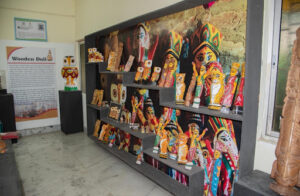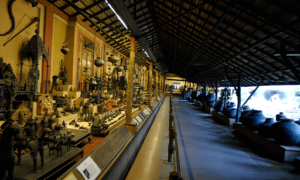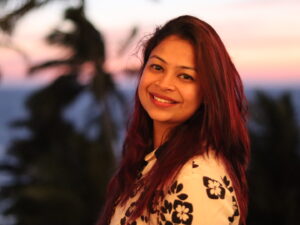Museums represent a public social investment by modern societies and their work in the field of education assists in the preservation of culture (Hein, 2005). Museums generate sensitivity for a bygone era, foster the spirit of community while addressing social issues, and have been evolving to become a space for narratives and lived experiences.

Community Museum showcasing folk culture of Rural Bengal (Source: Asia-Europe Foundation, https://culture360.asef.org/insights/community-museums-revitalising-folk-cultures-rural-bengal/)
The inclusion of the cultural identity concept in global cultural policies was recommended on the occasion of the World Conference on Cultural Policies (1982). Subsequently, new institutional models in the post-colonial and globalisation period have led to a variety of approaches by which nations, communities, or individuals seek to align to new, revisited, and often plural identities (UNESCO, 2010). Among the multiple approaches to museum conceptualization and revisiting identities is the community-based approach to museum development.
Community museums are “people centres” where traditions of the past, representing a pivotal aspect of the community, are preserved and promoted through documentation and outreach activities. In Gujarat, community museums represent their communities through ethnographic objects, indigenous structures, knowledge systems, and allied activities that help establish the identity markers of the representing communities. The textiles, crafts, vessels, and history associated with the community, on display, are more than just anthropological tools.
Community museums and craft
Community museums help community members act as primary keepers of their history and collective memory. The museums bridge the gap between generations, where the displayed art and craft are treated as a mode of intergenerational transfer of knowledge among community members. Indian museums have a wide range of traditional, religious, and cultural arts and crafts in their collections; some of which are the living heritage of certain communities (Parmar, 2013). The display not only helps create a sense of awareness about the community and its handiwork but also a sense of appreciation for the traditional craft of the state and country. Community museums are a reflection of the know-how of the craft as well as the importance of the indigenous materials used.
Vechaar Museum of Ahmedabad, Gujarat
Vechaar (an acronym for Vishalla Environment Center for Heritage of Art, Architecture, and Research) Museum, true to its name, refers to a way of thinking – the process which creates the bridge between imagination and reality. Vechaar Museum, the only utensil museum in India, houses over 4500 utensils from across the world and was established on 27th April 1981. The utensils and storage objects are exquisite, historical, and made of brass, terracotta, German silver, wood, ivory, bronze, and gold inlays. The objects have been collected over the years by the museum’s founder Shri. Surendra Patel with the support of noted anthropologist Dr. Jyotindra Jain. Vechaar Museum’s curation pays homage to the humble utensils that represent the daily life of the common man over centuries. The thought (vechaar) behind the museum’s conceptualisation was to showcase utensils and storage items that played a critical but understated role in the daily life, occasions, functions, travel, and situations of survival of the common man.
The museum boasts of a unique collection of more than 600 nutcrackers, a staple object of utility used in the Indian tradition of making ‘paan’, sourced from places around Gujarat. Furthermore, the Vechaar Museum has an exquisite collection of pots, pitchers, boxes, spouted pots, ceremonial accessories, water storage bags, tumblers, kitchen utensils, etc sourced from and representing the extraordinary craft in the daily life of the ordinary man. The collectibles showcase the work of Indian craftsmen, where utensils were individually handcrafted. The pots and other utensils have been tastefully sculpted to complement their form and function, thus, supporting AbdulRazzak’s (A.D. 1440) reference to Indian utensils as “Those rare and beautiful articles which the sun, the moon, and the rain have combined to bring into perfection”. The utensils represent the life of communities from the Harappan site of Kot Diji in Sindh, the desert regions of Kutch and Jaisalmer, and urban spaces of Gujarat, North India, far East, and down South. Yet, the displays convey a ‘vechaar’ (thought) of the common man, undivided by geography, behind designing each of these objects of utility.
The museum celebrates the function and importance of unnoticed humble utensils and objects of utility, in the words of the museum trustees, made by responsible people for whom their means of livelihood was a vocation and a profession. Vechaar Museum allows us to appreciate the beauty and sensibility of Indian craftsmanship in objects of daily life and conceptualise community as a sense of belonging to traditions and functions of life without geographical boundaries.
References:
Hein, G. E. (2005). The Role Of Museums In Society: Education And Social Action. Curator: The Museum Journal, 48(4), 357–363. https://doi.org/10.1111/j.2151-6952.2005.tb00180.x
Jain, J. (2015). Utensils: An introduction to the Utensils Museum, Vishalla, Ahmedabad (3rd ed.). Surendra C. Patel, Vechaar Foundation. (Original work published 1981)
Parmar, SM (2013). Developments of museums in Gujarat. As viewed on 8th March,2020 https://shodhganga.inflibnet.ac.in/bitstream/10603/59580/8/08_chapter%202.pdf.
UNESCO (2010).Community-based approach to museum development in Asia and Pacific for culture and sustainable development. As viewed on 8th March 2020 https://unesdoc.unesco.org/ark:/48223/pf0000189902
Author Bio:
Vasudha Saraogi is a cultural and sustainable development professional specialising in sustainable impact creation strategies. She is currently a doctoral scholar with O.P Jindal Global University, Sonipat pursuing sustainability studies; and has previously pursued postgraduate education in heritage management from Ahmedabad University.











Interesting Read!